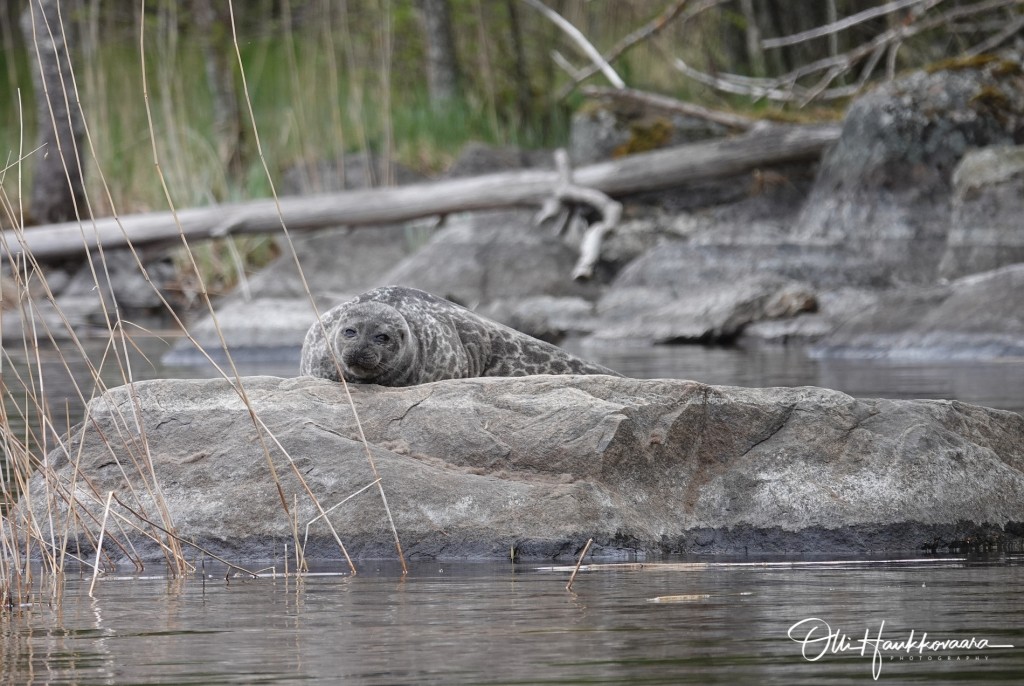In search of Saimaa Ringed Seal
Last weekend, on Saturday 25th of May 2019, I drove to estern Finland, just one species in my mind; the Saimaa Ringed Seal (Pusa hispida saimensis) – as I had not ever seen it. It is a subspecies of Ringed Seal (Pusa hispida). They are among the most endangered seals in the world, having a total population of only about 390 individuals and the only existing population of these seals is found in Lake Saimaa, Finland (hence the name).
They have lived in complete isolation from other ringed seal species for around 9,500 years and have diverged into a morphologically and ecologically different subspecies of Ringed Seal. The population is descended from Ringed Seals that were separated from the rest when the land rose after the last ice age. This seal, along with the Ladoga Ringed Seal and the Baikal Seal, is one of the few living freshwater seals. The taxonomy of Ringed Seal may change in future, i.e. both subspecies, Saimaa Ringed Seal and Ladoga Ringed Seal, may get a species status.
SaimaaHoliday Oravi is arranging seal safaris to Linnansaari National Park where lives about 60 Saimaa Ringed Seal and I had booked seats for myself and my family from their boat. The weather forecast was not the best – heavy rain was approaching from west. Our guide / motor boat operator drove right away to the best hotspot. And he really knew where the seals are – we saw total of 5 Saimaa Ringed Seals. I can really recommend SaimaaHoliday Oravi! After watching and photographing seals, we had a break on small island and had coffee / tea plus excellent tosca pie! Perfect seal trip!
While driving from home to Oravi and back we saw several other mammals; 6 European Hares (Lepus europaeus), 1 Mountain Hare (Lepus timidus), 3 Elks (Alces alces) and 1 White-tailed Deer (Odocoileus virginianus). Also some roadkills; 1 Roe Deer (Capreolus capreolus), 1 European Hedgehog (Erinaceus europaeus) and 1 Raccoon Dog (Nyctereutes procyonoides ussuriensis). And lot’s of molehills of European mole (Talpa europaea) in small park near Olavinlinna castle.

Saimaa Ringed Seal (Pusa hispida saimensis) in Linnansaari National Park, Finland
13 Comments
-
-
Jeff
Great sightings! They look very “harbour seal-like”.
Just a couple comments re: taxonomy:
1) Pusa is now generally accepted as the generic name for ringed (and Baikal and Caspian) seals. See, for example, the Society for Marine Mammalogy’s nomenclature list – https://www.marinemammalscience.org/species-information/list-marine-mammal-species-subspecies/
2) as noted in point 1, the Baikal seal (Pusa sibirica) is a full species (while the Ladoga seal is considered a ringed seal subspecies, as you note)
Jeff
-
Jeff
(Apologies if this posts twice, internet router issues…)
There’s also a ringed seal population that occurs in freshwater in Arctic Canada, in Nettelling Lake (roughly “lake of seals” or “lake with seals”) on Baffin Island. They were described as a subspecies in the 1940s (Pusa hispida soperi), based on specimens collected by Dewey Soper in the mid-1920s. But that was in the days of extensive taxonomic splitting, and was based (as was often the case) on a very small sample size, and the subspecies isn’t formally recognized at this stage (they are [presumably…] Pusa hispida hispida – the widespread Arctic Ringed seal subspecies).
I’m known about these seals for years, but recently flew over the lake en route to Pond Inlet and that has rekindled my interest. In my spare time I’ve been putting together information on past observations, history of expeditions to the lake, etc. Hopefully can turn this into some research funds at some point, as I’d love to do some work on this population. This type of natural history work is difficult to fund these days though. Some writers suggest that they don’t stay in the lake year-round, but others suggest they do. I suspect they do, as the best foraging in the lake would occur in winter after the anadromous Arctic char stocks have gone upriver. The seals could access Foxe Basin via the Koukjuak River, the same one the char use. There is also at least one connected lake, possibly two, that reportedly also have resident ringed seals.
Jeff
-
Kelchtermans Jan
According my connection/experience with Saimaannorppa (Finnish for the Saimaa-ringed Seal) while guiding (about a decade now) in Finland, I wrote a small text about it. A marvelous animals in a amazing scenery and, in my opinion a must target & to add NP (Linnansaari) when visiting Finland!
Late winter – early spring support (making artificial denning areas) done by nature lovers for sure helps them in their survival!
Feel free to read it:
https://www.europesbig5.com/news/the-saimaa-ringed-seal/
Cheers, Jan
-
-
Jeff Higdon
Agree Vladamir, so I would not take that bet 🙂
I haven’t been following pinniped taxonomy and phylogeny research much recently, not since finishing my PhD in 2011, but the evidence available then was clear that there are taxonomic issues within Phocina. We recovered a paraphyletic Pusa, with Halichoerus nested within, in our 2007 multigene dataset supertree paper (in BMC Evolutionary Biology). Other papers at the time found somewhat similar (or similarly confusing…) results.
-
-
Vladimir Dinets
Jan: now I know where Russian word “nerpa” (small seal) comes from 🙂
Jeff: yes, I remember that paper. Just one of so many issues with traditional marine mammal taxonomy. I hope it will all get reformed rather than entrenched.
Leave a Reply
You must be logged in to post a comment.


Conuropsis
How cool! I’ve never heard of them. I know of the Baikal and Caspian Seals and of a few Harbor Seal populations that are supposed to be in Canada, but never a freshwater Ringed Seal population. If I ever get to Finland I want to see them. Thanks for posting.
Andrew